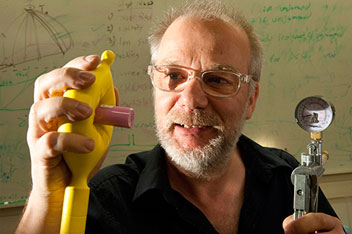But a group of researchers have bypassed traditional notions of robot hand design and created a gripper using coffee and a balloon.
Unlike a hand, which would require a great deal of elaborate instructions to pick up random objects with crushing them, their 'universal gripper' conforms to the object it's grabbing. Basically, a party balloon is filled with ground coffee and attached to a robotic arm. The coffee-filled balloon presses down and deforms around the desired object, and then a vacuum sucks the air out of the balloon, solidifying its grip. When the vacuum is released, the balloon becomes soft again, and the gripper lets go.
Particulate materials, large aggregates of individually solid particles, have a so-called jamming transition, which turns their behavior from fluid-like to solid-like when the particles can no longer slide past each other. Coffee is an example of a particulate material - this is why vacuum-sealed coffee is as hard as a brick until the package is unsealed.

University of Chicago physicist Heinrich Jaeger uses a soft gripper to hold up a vial. The gripper consists of a rubber membrane around a granular material that can form around objects, then grab them when a vacuum pump is used to harden the material. The gripper was designed to allow robots to pick up various objects without a lot of computational overhead. Credit: Lloyd DeGrane
"The ground coffee grains are like lots of small gears," said Hod Lipson, Cornell associate professor of mechanical engineering and computer science. "When they are not pressed together they can roll over each other and flow. When they are pressed together just a little bit, the teeth interlock, and they become solid."
The concept of a particulate material jamming transition provides a framework for understanding and predicting behavior in a wide range of disordered, amorphous materials. All of these materials can be driven into a 'glassy' state where they respond like a solid yet structurally resemble a liquid, and this includes many liquids, colloids, emulsions or foams, as well as particulate matter consisting of macroscopic grains.
A robotic arm displays the possible applications of the universal gripper. Source: John Amend and Hod Lipson, Cornell University
Unlike in science, coffee is not required (though beer won't work at all) but anything that can jam is a suitable particulate material. Early prototypes involved rice, couscous and even ground- up tires. They settled on coffee because it jams well and is also light whereas sand did better on jamming but was prohibitively heavy. What sets the jamming-based gripper apart is its good performance with almost any object, including a raw egg or a coin – both notoriously difficult for traditional robotic grippers.
"This is one of the closest things we've ever done that could be on the market tomorrow," Lipson said.
He noted that the universality of the gripper makes future applications seemingly limitless, from the military using it to dismantle explosive devises or to move potentially dangerous objects, robotic arms in factories, on the feet of a robot that could walk on walls, or on prosthetic limbs.
Citation: Eric Brown, Nicholas Rodenberg, John Amend, Annan Mozeika, Erik Steltz, Mitchell R. Zakin, Hod Lipson, and Heinrich M. Jaeger, 'Universal robotic gripper based on the jamming of granular material', PNAS 2010 107 (44) 18809-18814; published ahead of print October 25, 2010, doi:10.1073/pnas.1003250107





Comments